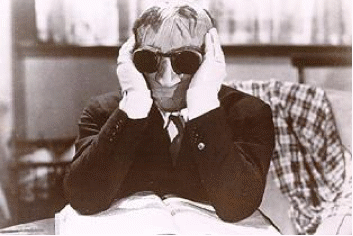In observance of that autumn spell when we celebrate the primal, compulsive instinct of fear, Rainestorm once more highlights 31 days of spooky scares to season the eerie atmosphere of Halloween.
For those who tuned in last year, I subjected you to a daily dose of diabolical dread and devilish distress. Just as every good horror movie deserves an inferior sequel, I offer this follow-up of also-rans, not bads, and perhaps a couple of you’ve-gotta-be-kidding-mes.
Unleashed: 1933

I know! I’ll spend most of the film naked!”
What evil lurks: Rainestorm, indeed! Tonight, I give you another Rains (minus the “e”) — Claude Rains! That’s right, today’s entry is all about The Invisible Man. With the success of Dracula and Frankenstein in 1931, Universal Studios was looking for the next big screen horror villain to fill the theater seats with thrill seekers. H.G. Wells gave them their golden goose in the form of a scientist named Dr. Jack Griffin who creates a formula that makes him invisible. Unfortunately, it has the minor side effect of making him a homicidal maniac with plans for world domination.
James Whale, who was riding high from his success on Frankenstein, was given the task of directing the Wells adaptation. Many of his touches and eccentric sense of humor are felt throughout the film, but his true inspired moment was in eavesdropping on the screen test of a relatively unknown theater actor named Claude Rains. The challenge of The Invisible Man was to present a main character who is rarely seen; Rain’s voice solved that challenge in spades. With his rolled “r’s” and manic, high-pitched laughter, the world was given one of the most memorable screen villains.
Full credit must also be given to the combined genius of John P. Fulton, John J. Mescall, and Frank D. Williams, the special effects pioneers whose remarkable innovation made it possible for a half-naked invisible man — essentially a disembodied shirt — to run around the room. In 1933, special effects were a matter of problem solving and invention, and the effects used in The Invisible Man are astounding, even by modern standards.
Highlight from hell: The inimitable Una O’Connor gives us the true scream queen. Her birthday was just a few days ago on October 23rd. She would have been 131 years old!
Terrifying trivia: This was the first sound film for actor Claude Rains (who played the titular character). His voice has proven to be one of the most memorable aspects of this film.
Diabolical dialogue: “Power, I said! Power to walk into the gold vaults of the nations, into the secrets of kings, into the Holy of Holies! Power to make multitudes run squealing in terror at the touch of my little invisible finger! Even the moon’s frightened of me — frightened to death!”
Son of: Frankenstein (1910). The rise of the Gothic horror novel and short story in the post-Victorian age provided an absolute gold mine for the brand new medium of moving pictures. Horror proved to be a very successful genre, and one that film was particularly suited to. One of the first adaptations was of Mary Shelley’s “Frankenstein” by Edison Studios back in 1910. Since then, the proclivity of Hollywood to adapt macabre literature grew into what some still consider the Golden Age of horror films: Leroux’s “The Phantom of the Opera“, Stevenson’s “Dr. Jekyll and Mr. Hyde“, and Bram Stoker’s “Dracula” are prime examples. Before H.G. Wells’s “The Invisible Man“, another of his novels, “The Island of Dr. Moreau“, was adapted as Island of Lost Souls in 1931.
Shoddy sequel syndrome: Director James Whale must have been the pioneer of the trope of the bumbling, incompetent police force. By the by, when the character of the Invisible Man returned in Abbot and Costello Meet Frankenstein, he was voiced by none other than Vincent Price.


One response to “Son of 31 Nights, 31 Frights: The Invisible Man”
I know I’m the odd man out here but I find Una O’Connor to be absolutely insufferable in both this and the highly overrated Bride of Frankestein.